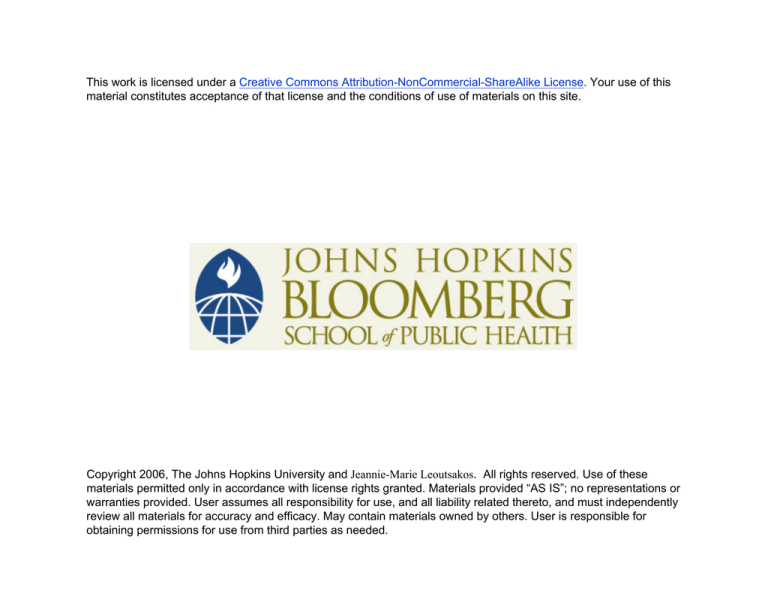
This work is licensed under a Creative Commons Attribution-NonCommercial-ShareAlike License. Your use of this
material constitutes acceptance of that license and the conditions of use of materials on this site.
Copyright 2006, The Johns Hopkins University and Jeannie-Marie Leoutsakos. All rights reserved. Use of these
materials permitted only in accordance with license rights granted. Materials provided “AS IS”; no representations or
warranties provided. User assumes all responsibility for use, and all liability related thereto, and must independently
review all materials for accuracy and efficacy. May contain materials owned by others. User is responsible for
obtaining permissions for use from third parties as needed.
Statistics in Psychosocial Research
Lecture 6
Validity II
Lecturer: Jeannie-Marie Leoutsakos
Outline
• Roadmap
• Criterion Validity – ROC
• Construct Validity - MTMC
Validity
weak
Face Validity
Content Validity
Criterion Validity
predictive, concurrent, postdictive
good
Construct Validity
a) internal
i) discriminant
ii) convergent
b) external/nomological
Criterion Validity
1. Correspondence between a test item and a criterion
variable. The size of the correspondence is a direct
measure of the amount of criterion validity
2. Requires a gold standard
3. Highlights correspondence alone
Sensitivity & Specificity
• Sensitivity – Does the Test Identify Cases?
P(T+|D+) =
A
A+C
• Specificity – Does the test Identify Non-cases?
P(T-|D-) =
D
B+D
Positive & Negative Predictive Value
• PPV – What does a positive test result mean?
P(D+|T+) =
A
A+ B
• NPV – What does a negative test result mean?
P(D-|T-) =
D
C+D
Sensitivity and Specificity of a Blood Glucose Level of 5.6 mM
for Determination of Diabetes Status
– True Disease Status –
Blood Glucose Level (mM) Diabetics
Nondiabetics
>= 5.6 mM classified as
diabetics
62 (A)
215 (B)
<5.6 mM classified as
nondiabetics
1 (C)
125 (D)
Sensitivity =
Specificity =
Positive predictive value =
Negative predictive value =
Sensitivity and Specificity
Sensitivity and specificity of 2-hour postprandial blood test for glucose for 63 true diabetic patients
and 340 true nondiabetic patients at different levels of blood glucose
Reference Value (mg/dl)
Blood Glucose (mM)
Sensitivity* (%)
Specificity* (%)
80
4.4
100.0 (63/63)
0.6 (2/340)
5.1
100.0 (63/63)
19.7 (67/340)
5.6
98.4 (62/63)
63.2 (215/340)
6.1
95.2 (60/63)
93.5 (318/340)
6.4
95.2 (60/63)
97.4 (331/340)
6.7
84.1 (53/63)
100 (340/340)
7.2
74.6 (47/63)
100 (340/340)
7.8
66.7 (42/63)
100 (340/340)
8.3
55.6 (35/63)
100 (340/340)
8.9
44.4 (28/63)
100 (340/340)
9.4
36.5 (23/63)
100 (340/340)
10.0
33.3 (21/63)
100 (340/340)
10.6
30.2 (19/63)
100 (340/340)
11.1
23.8 (15/63)
100 (340/340)
115
140
200
Figures in parentheses are the number of diabetic patients with 2-hour postprandial blood glucose level at or above
the specified level.
Source: Wadena County Health Study (unpublished)
Relation between the Prevalence of Disease in a Population and the
Positive and Negative Predictive Value of a Test
Population
Prevalence
Positive
Rate
Predictive
(per 100 persons) Sensitivity Specificity Value
15.6
.98
.37
.22
23
.98
.37
.32
37.5
.98
.37
.48
Negative
Predictive
Value
.99
.99
.97
Validity
weak
Face Validity
Content Validity
Criterion Validity
predictive, concurrent, postdictive
Construct Validity
good
a) internal
i) discriminant
ii) convergent
b) external/nomological
Multi-trait Multi-method
• Assesses construct validity
• Campbell & Fiske (1959)
• multiple concepts (traits) and multiple
methods (scales or observers)
• matrix of correlation coefficients
Synthetic Example- Method Blocks
Synthetic Example – Reliability Diagonals
Reliability Coefficients should be the highest values in the matrix
Adapted from http://www.socialresearchmethods.net/kb/mtmmmat.htm
Synthetic Example – Validity Diagonals
Validity coefficients (Mono-trait Hetero-method – MTHM)
these should be sig. different from 0 (convergent)
Adapted from http://www.socialresearchmethods.net/kb/mtmmmat.htm
Synthetic Example – Hetero-trait Mono-method
Validity coefficients should be greater than any
HTMM coefficients (traits should “hang togther”
more closely than methods)
Adapted from http://www.socialresearchmethods.net/kb/mtmmmat.htm
Synthetic MTMM – Hetero-trait Heter-method
Validity coefficients should be greater than the
HTHM coefficients in the same row and column
Adapted from http://www.socialresearchmethods.net/kb/mtmmmat.htm
MTMM(Reliability) > MTHM(Validity) >
Adapted from http://www.socialresearchmethods.net/kb/mtmmmat.htm
HTMM
HTHM
Another Perspective (Inside out)…
Adapted from http://www.socialresearchmethods.net/kb/mtmmmat.htm
A Multitrait-Multimethod Matrix Assessing Children’s Mental Disorders
Child
Mother
Father
Dep. Anx. Ext. Dep. Anx. Ext. Dep. Anx. Ext.
Child
Dep. (.75)
Anx.
(.74)
Ext.
(.72)
Mother
Dep. .26
(.71)
Anx.
.22
(.76)
Ext.
.41
(.81)
Father
Dep. .11
.27
(.65)
Anx.
.05
.48
(.62)
Ext.
.21
.57
(.76)
A Multitrait-Multimethod Matrix Assessing Children’s Mental Disorders
Child
Mother
Father
Dep. Anx. Ext. Dep. Anx. Ext. Dep. Anx. Ext.
Child
Dep. (.75)
Anx.
(.74)
Ext.
(.72)
Mother
Dep. .26
.24
.15
(.71)
Anx. .15
.22
-.00
(.76)
Ext. .38
.34
.41
(.81)
Father
Dep. .11
.10
.07
.27
.21
-.04 (.65)
Anx. -.01 .05
-.12 .31
.48
.10
(.62)
Ext. .24
.19
.21
.21
.16
.57
(.76)
A Multitrait-Multimethod Matrix Assessing Children’s Mental Disorders
Child
Mother
Father
Dep. Anx. Ext. Dep. Anx. Ext. Dep. Anx. Ext.
Child
Dep. (.75)
Anx. .38
(.74)
Ext. .51
.55
(.72)
Mother
Dep. .26
.24
.15
(.71)
Anx. .15
.22
-.00 .64
(.76)
Ext. .38
.34
.41
.35
.31
(.81)
Father
Dep. .11
.10
.07
.27
.21
-.04 (.65)
Anx. -.01 .05
-.12 .31
.48
.10
.48
(.62)
Ext. .24
.19
.21
.21
.16
.57
.30
.29
(.76)
A Multitrait-Multimethod Matrix Assessing Children’s Mental
Disorders
Mental Disorder
Ci
Ce
Mi
Me
Fi
Fe
Child Report
Internalizing
(.77)
Externalizing
.64
(.74)
Mother Report
Internalizing
Externalizing
.28
.43
.07
.41
(.78)
.36
(.81)
Father Report
Internalizing
Externalizing
.09
.26
-.03
.21
.42
.21
.04
.57
(.68)
.34
(.76)



